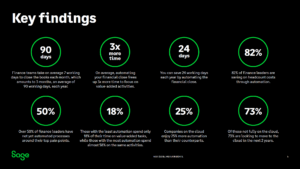Why Resist the Cloud Adoption?

AI in financial services: is it hot or hype?
June 6, 2023
Are we Adequately Prepared for the Significant Influence of Generative AI on the Field of Accounting and Finance?
October 4, 2023Amplify your impact through automation
Today’s finance leaders face a host of unique business challenges, from economic uncertainty to compliance, cybersecurity risks, and the everchanging expectations of their role. These factors directly impact the time it takes to close the books each month, with most teams spending nearly 3 months a year on month-close activities alone, according to Sage’s research.
More and more finance leaders want to unchain their teams from repetitive clerical tasks and empower them to focus on higher value, high-impact strategic activities. That’s where Sage’s 6th annual Close the Books survey comes in. They conducted a worldwide survey involving over 1,000 finance professionals from across the globe and different industries to uncover trends and insights on achieving faster and more accurate financial closing—a coveted prize for any finance department. The report aims to better understand the people, processes, and technology that finance leaders use to close their books each month, quarter, and year—with intriguing results:

sage intacct implementation specialist Australia
Quicker close – bigger impact
Finance leaders who embrace automation cut their closing time by 29%, which translates to 2 days every month—a staggering 24 days a year. Finance teams embracing the highest levels of automation have 3x more time to spend on impact-driven value-added activities including:
• Data analysis
• Training and personal development
• Strategic planning
• Team building
• Personal wellbeing
Sage’s research report shows just how significant a role automation plays in freeing up that time. Respondents with the lowest level of automation available spend only 18% of their time on value added tasks, while those with high levels of automation at their disposal spend almost 58% on these activities.
“Through automation, finance leaders and their teams are empowered to lead a more balanced and fulfilling life. It’s about prioritizing what truly matters to create a bigger impact—whether you’re building a team, developing your career, or taking better care of yourself.”
Sara Arthrell, Head of Industry Solutions Marketing at Sage
Moving to the cloud
The survey revealed that cloud adoption is a significant factor in your path to being fully automated. Those that have adopted a cloud solution are on average 25% more automated than those that have not adopted a cloud solution. Currently, just a shade over half of CFOs have fully migrated to the cloud. However, brace yourself for a seismic shift, as this statistic is set to catapult to 73% within the next 2 years.
Picture this: Your team fully empowered by the capability to wrap up the financial close at an unprecedented pace, leaving competitors trailing behind.
The alternative? Your rivals racing ahead, driven by the momentum automation provides, while your team grapples with manual processes.
Why resist the cloud adoption?
Sage asked their customers for their insights on what might get in the way of cloud adoption. Their observations reveal concerns around complexity, data security, and a fear of change. Let’s take a closer look at some of the barriers that might get in the way of cloud adoption..
Resistance to change: Some employees may feel apprehensive about new technologies, fearing job displacement or a lack of control. It’s important to address these concerns
through effective communication and change management strategies, highlighting the benefits of automation in enhancing productivity, reducing errors, and enabling employees to focus on higher-value tasks, personal development, and their overall wellbeing.
Limited awareness: Some decision-makers might not have a full picture of what automation can do for them, or may lack the knowledge to roll these solutions out effectively and sustainably. In these cases, education is crucial. Finance leaders are uniquely positioned to show their organisation the potential of automation, and provide guidance around the kind of training and support needed to ensure successful implementation.
Cost vs. Return on Investment (ROI)
Implementing automation solutions often requires an initial investment of resources, both in terms of software and infrastructure. Key decision-makers might hesitate, citing concerns about the upfront costs and uncertainty around the ROI they can expect, and when they’ll start to see it.
Demonstrating the long-term cost savings, increased efficiency, and improved accuracy that automation can bring will help soothe these concerns and
highlight the financial benefits.
Legacy systems and broken processes
Legacy systems and fragmented processes can present challenges when integrating automation solutions. Companies may need to invest in system upgrades or redesign existing processes to fully leverage automation capabilities.
Overcoming these obstacles requires a careful assessment of the existing infrastructure and a well-planned implementation strategy that ensures seamless integration and minimal disruption.
Security concerns
Companies dealing with sensitive financial data may have concerns about the security and privacy implications of automation.
It is crucial to address these concerns by implementing robust security measures, such as encryption, access controls, and regular audits, to protect data integrity and confidentiality.
Demonstrating compliance with industry regulations and certifications can help alleviate these concerns and build trust. By addressing these challenges head-on, providing comprehensive support, and showcasing the tangible benefits of automation, companies can overcome the barriers and unlock the full potential of automation in their finance and accounting processes.
We used to spend two days a week manually generating statements and attaching to individual emails; now it’s less than an hour thanks to Sage’s automation.
James Proctor, Director of Professional and Managed, Services at Phase 3
Conclusion
This year’s global Close the Books survey reveals an exciting truth: the accelerated growth of finance teams all over the world are harnessing the power of automation to amplify their impact and reclaim their most valuable resource—time.
By automating their most tedious tasks associated with period-end closes, especially through cloud-based accounting software, finance leaders are unlocking their potential and increasing impact on their companies via greater productivity, efficiency, and reporting accuracy across their team.
But here’s the real gem: it’s not just about saving time. It’s about freeing up resources and reclaiming what truly matters, and having the space to use your
expertise on work only you could do.
With more time on your hands, you can get into the flow of more meaningful strategic work. Imagine building a stronger, more productive finance function, investing in your own professional development, and making an even greater impact not just in your organisation, but in your industry and your career, too.
Overall, the true value lies in transforming not only your work, but your life. It’s time to seize the opportunities that technology and automation provide with both hands, and reclaim the time and energy you need to flourish.
Want to find out more?
Cut your close time with powerful automation from Sage. Explore the key features of Sage at your own pace, from reporting to month-end close. See first-hand how powerful functionality combined with the simplicity of a cloud-native application drive strong ROI.
Content source: Sage Research Report “Fast close. Faster insights.” / Photo by Adeolu Eletu on Unsplash

